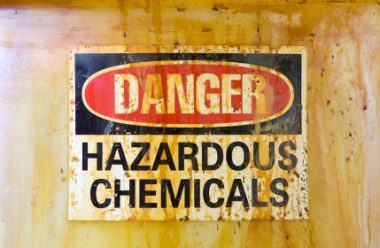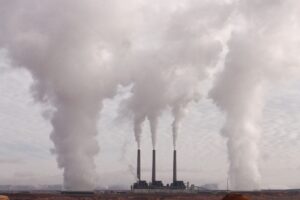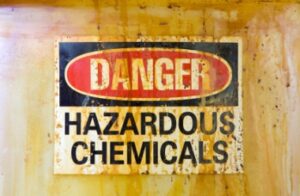
Did you know on average, each person in the United States produces an average of 4lbs of household hazardous waste each year?
It is a common thought to believe that the “small” amount of hazardous household waste each individual produces makes such a minimal impact on the world. Nearly every activity leaves behind some kind of waste in the environment. When you take into account how many people there are in the world – 7.4 billion to be exact – that waste adds up quickly. This number becomes especially frightening when looking at the amount of hazardous waste generated and disposed of, in the United States alone, which is estimated to be 7.6 billion of tons per year. Between the years of 1930 and 2000, global production of man-made chemicals increased from 1 million to 400 million tons each year and has been steadily increasing since then.
Hazard vs. Risk
The terms “hazard” and “risk” are often interchanged and thought to have similar meanings to most of us. In reference to chemicals though, the terms are quite different.
 Hazard – refers to the inherent properties of a chemical substance that make it capable of causing harm to a person or the environment.
Hazard – refers to the inherent properties of a chemical substance that make it capable of causing harm to a person or the environment.- Risk – is the possibility of harm arising from a particular exposure to a chemical substance, under specific conditions.
To understand risk, we need to know both what the inherent hazard is and the degree of exposure. With every hazardous material, there is a risk of potential harm being done, which is increased by how much of the hazardous material is exposed to certain things. An example being hydrofluoric acid: This chemical is used in pharmaceuticals which is generally a safe practice, however, if someone working with this acid accidentally gets it on themselves, it will likely cause 3rd degree burns. Potential exposure to the chemical is high if the chemical is handled with bare hands without proper personal protection equipment (PPE). This creates a high-risk situation.
Once we understand the risk of something, we can then either reduce it or manage it. Many businesses are not able to reduce the amount of waste they create so they must look to manage it. In the example above, a way to reduce the hazard is to handle the chemical properly and the person handling it wears the proper personal protection equipment, which lowers the risk of burns. If a chemical is no longer needed for production, another way to lower the exposure risk is to look for the best environmental waste disposal method to minimize the impact on humans and the environment.
How Chemicals Move Through the Environment
The different ways a person can come into contact with hazardous chemicals are called exposure pathways. There are three basic exposure pathways: inhalation, ingestion, and dermal (skin) contact. Since chemicals can move through air, soil and water, they can be found in the air we breathe, the soil our plants grow in, water we drink, and the food we eat. Some common ways a person may be exposed to hazardous chemicals include:
- Water – Exposure can occur when people drink, shower, bath, or swim in contaminated groundwater or surface water. If someone goes swimming in waters that have been polluted by chemicals, they may not realize it until they’re having a reaction.
- Soil, Sediment, or Dust – Exposure can occur if contaminated soil, sediment or dust is inhaled or makes direct contact with skin. This form of exposure is very common in children and is currently a huge problem in Imperial County, California.
- Air – Exposure can occur when people breathe in hazardous chemical vapors or air that is contaminated by hazardous chemicals or dust.
- Food – Exposure can occur when people eat certain foods that have been contaminated. Food contamination can occur if the food has come into contact with hazardous chemicals either through water, or in secondary consumers being contaminated by primary consumers.
How Hazardous Waste Affects Human Health
The occurrence of adverse health effects is dependent on the way the hazardous chemical enters the body. Some hazardous chemicals absorb rapidly through the skin, while others don’t at all. The toxicity of a chemical also determines the effect on the body. There are many hazardous chemicals are toxic in very small amounts, whereas others can have large volumes of exposure before there is a reaction. Up to 300 man-made chemicals have been found in the average human. Having hazardous chemicals in the human body causes adverse reactions to fetuses, children, adolescents, adults and the elderly but the reaction each may have varies. A fetus and young child is more susceptible to adverse reactions than an adult because their developing organs may be permanently damaged. Some potential health conditions in people of all ages include:
- Behavior abnormalities
- Cancer
- Physiological malfunctions (e.g., kidney failure, reproductive impairment)
- Genetic mutations
- Physical deformations
- Birth defects
By not disposing of hazardous wastes properly, these same wastes will likely circle back around and could affect you or your family ten-fold, is that a risk worth taking?
For more information on certain chemicals, such as the likely health effects, visit the Agency for Toxic Substances and Disease Registry’s ToxFAQs website.
Reducing the Impact of Toxic Waste
The Environmental Protection Agency (EPA) has created informational outlines on designated chemicals to define how people can be exposed to hazardous chemicals and how contact to them might affect their health. The outlines also describe what happens to chemicals in the environment, who regulates them, and who people should contact for more information. Wastes are broken down into four categories and each has their own regulations and handling requirements.

It is necessary to keep in mind the long-term affect these wastes have on personal, local, national and global levels. For example, in our blog Waste Conversion – Our Responsibility to future generations we took a look at Emelle, Alabama. In 1978, Chemical Waste Management purchased a landfill for a 300-acre tract of land near the village of Emelle. Since acquiring the landfill, millions of tons of hazardous waste have been dumped on the prior farmland, which has created the largest hazardous waste landfill in the United States. The landfill is now 2,700 acres and sits directly over the Eutaw Aquifer, which supplies water to a large part of Alabama. The Emelle landfill is not the only landfill of the sort but it is certainly the largest in the United States. If hazardous waste continues to be disposed of improperly, this landfill will continue to grow or more of the same kind could be created. Companies that specialize in the disposal and handling of hazardous waste, make it their priority to either burn off chemical wastes or treat the chemical waste in a way that diminishes any potential harm it could do to the environment. Any time you are about to throw something into the trash, take a moment to determine if it is toxic. If you throw this item into the trash, keep in mind that you are making steps towards creating a hazardous waste landfill in your backyard. Is that how you want to leave this country for your children and grandchildren?
Take the Next Step!
Hand the stress of worrying about our future generations over to experts who have the training and experience to handle hazardous waste materials. Contact us today to discuss your hazardous waste disposal needs.


 Hazard – refers to the inherent properties of a chemical substance that make it capable of causing harm to a person or the environment.
Hazard – refers to the inherent properties of a chemical substance that make it capable of causing harm to a person or the environment.